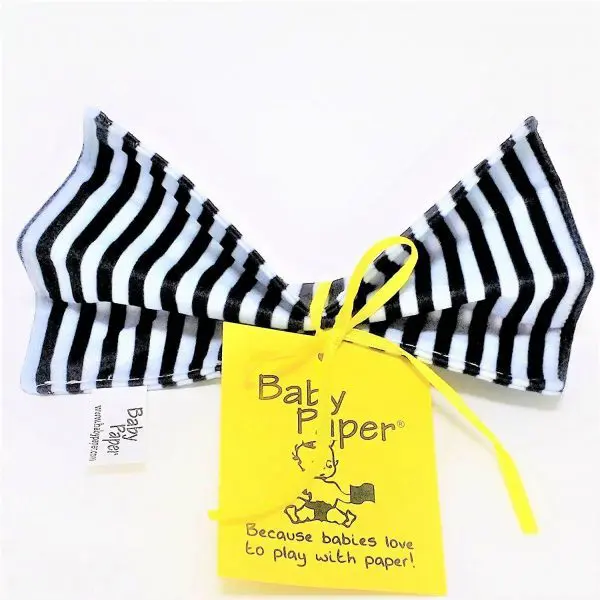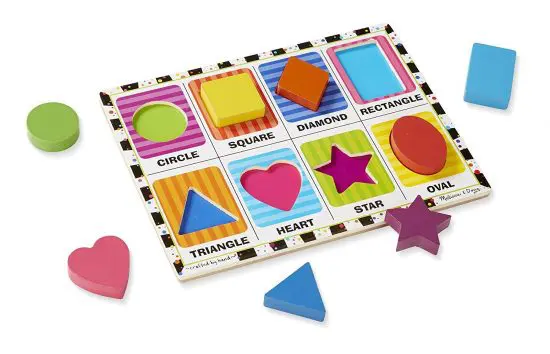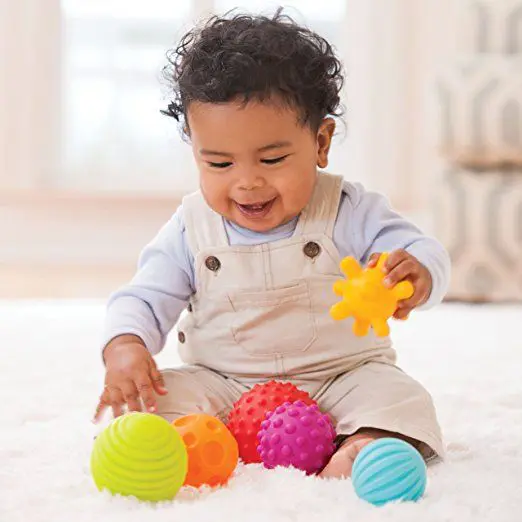I was recently asked for advice on choosing toys for a toddler when there is also an infant in the house. Interestingly, I wasn’t able to find much information on the topic via The Great Google. So either everyone is wondering about this in silence, or lots of parents prove that joke that folks get way less worried with each kid. Anyway, it looks like there’s good news for parents of two under two or any other combination of toddler and infant: at this stage, it’s not that hard to choose toys that are safe for everyone! Here’s my advice on choosing toys in an infant-toddler household.
(Note: I’m defining an infant as 0-12 months old, and a toddler as 1-3 years old)
The guidelines for choosing infant toys include the following:
- Infant toys should be safe for mouthing, which includes high-quality manufacturing, non-toxic materials, and washable. Toys should contain no small parts; no piece of the toy should be able to fit inside a toilet paper tube. (No toys with plastic eyes or buttons, cars should be large and simple—not the little die-cast kind, etc.).
- Also, pay attention to what soft toys are stuffed with. Avoid beans or pellets which can become a choking hazard if the item gets torn.
- Avoid toys that generate sound electronically, as these can be entirely too loud for your baby’s ears.

Some ideas for infant toys include:
- Young infants who aren’t mobile yet enjoy toys that they can move and make sounds with, toys that they can safely put in their mouths, soft toys or toys with interesting textures, and toys with high visual contrast. Think rattles; teethers in various materials (silicone, wood, etc.); soft dolls, books, or stuffed animals; baby paper; or large sensory balls.
- Older infants who are on the go can enjoy the same toys they did when they were younger. They also enjoy toys that let them take objects out and put them back in, like shape sorters or nesting toys. Toys that move like cars or balls are fun for this age, too. This a great age to introduce large cube-shaped blocks, including silicone/vinyl blocks, wood blocks, and soft blocks.
And you want to know what the guidelines are for choosing toys for toddlers? Pretty much the same, as far as safety goes! You’ll notice that lots of toys with small parts (including dolls with plastic vs. painted or sewn-on eyes) are labeled for ages three years and up—in other words, preschoolers, not toddlers.
 While there’s still life left in infant-appropriate toys (I just talked to someone who’s seven-year-old still loves her Tupperware shape sorter—a conversation we had while my five-year-old was playing with it), here are some ideas for toddler toys:
While there’s still life left in infant-appropriate toys (I just talked to someone who’s seven-year-old still loves her Tupperware shape sorter—a conversation we had while my five-year-old was playing with it), here are some ideas for toddler toys:
- As toddlers become less prone to mouthing books, board books become a great toy.
- Smaller blocks than you might not give an infant, but still large enough that they can’t fit in the child’s mouth.
- Easy puzzles like cube puzzles, chunky puzzles, or knob puzzles, as well as activity boards with knobs, slides, zippers, (large) buttons, doors, panels, etc.
- Pretend play items like baby dolls, kitchen sets, tools, and dress-up items.
- Art supplies like washable markers and paints, and chunky, sturdy crayons.
- Balls encourage little bodies to active, and you can provide your toddler with balls of various sizes and textures to play with.
- Ride-on toys. (Always check the manufacturer’s instructions, but these are generally safe for children who are able to sit up well while not supported.)
 And don’t forget about the non-toy toys, too, like clean, empty food storage containers, wooden stirring spoons, lightweight pots and pans, and other kitchen items! These can be fun for older infants and toddlers alike. Toddlers who are past the “mouthing” stage might also enjoy tearing paper (junk mail, old magazines and catalogs, etc.).
And don’t forget about the non-toy toys, too, like clean, empty food storage containers, wooden stirring spoons, lightweight pots and pans, and other kitchen items! These can be fun for older infants and toddlers alike. Toddlers who are past the “mouthing” stage might also enjoy tearing paper (junk mail, old magazines and catalogs, etc.).
The great news about safety guidelines being similar for toddlers and infants is that parents don’t have to panic too much about keeping the toys segregated. You’re not giving your toddler LEGO or anything. Basically, toys for toddlers are more complicated than toys for infants, as toddlers are increasing their physical dexterity through the use of their fine and gross motor skills. They are also developing problem-solving skills. So while your infant may not know what to do with a puzzle of chunky shapes, it’s not going to hurt them to hold the pieces and move them around.
If you have toys that you do want to keep away from your infant (perhaps a board book they’re likely to chew on or an activity board that might be a risk for pinching tiny fingers), those toys can be kept out of reach. That way, an adult will have to get them down, can be present while they’re being played with, and can ensure they’re put safely away when play time is over. These can also be “special” toys that your toddler can play with while the baby is napping or nursing.
As long as you’re following general safety guidelines, you should be fine to stock your infant-toddler household with fun and developmentally appropriate toys that are safe for all your littles! We’d love to hear your advice and experiences about managing toys for infant/toddler set, so please share your knowledge in the comments.

